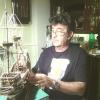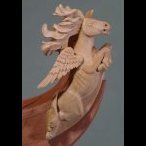-
Posts
8,149 -
Joined
-
Last visited
Reputation Activity
-
 allanyed reacted to druxey in Has anyone carved the stern decorations of HMS Pegasus?
allanyed reacted to druxey in Has anyone carved the stern decorations of HMS Pegasus?
No. However, a larger scale mock-up with modelied clay sculptures should help you figure out how to carve them in wood. I've found that process to be helpful on other models, an example of which is attached.
-
 allanyed got a reaction from trippwj in Framing of the Gunports on 18th Century English Ships
allanyed got a reaction from trippwj in Framing of the Gunports on 18th Century English Ships
Thank you very much Wayne, I had not seen those and appreciate you posting. Alas, I am looking for drawings with cant framing in the disposition drawing and a bit more detail.. The drawings I am used to seeing show offsets and canting of the various futtocks around gun ports, sweep ports, etc. Sutherland is pretty basic, not unlike the majority of framing on the contemporary dockyard models. I wonder if the Sutherland drawing is supposed to be more suggestive than actual. Some of the gun ports do not meet the framing on both sides and others show half the siding of a frame cut away to allow the gun port in place.
Two examples of dispostion drawings from the National Maritime Museum Collections website are attached, a 74 from 1763, and a 50, the drawing of which is from 1776. Sorry to be so picky. I really do appreciate your taking the time to post your response.
Allan
-
 allanyed reacted to James H in Looking for a Teach-in on Painting?
allanyed reacted to James H in Looking for a Teach-in on Painting?
No politics here guys, there is no place for it....
We are a hobby site.
-
 allanyed got a reaction from dgbot in HMS Vulture 1776 by Dan Vadas - FINISHED - 1:48 scale - 16-gun Swan-class sloop from TFFM plans
allanyed got a reaction from dgbot in HMS Vulture 1776 by Dan Vadas - FINISHED - 1:48 scale - 16-gun Swan-class sloop from TFFM plans
Danny
I like the varying vee block set up. Are there just the two we see in the photo or do you have more to support longer pieces so they do not bend during the chiseling process? I am very happy to see you demonstrate that a sharp chisel can do wonders, and dowels are not necessary to make masts or spares.
Allan
-
 allanyed got a reaction from druxey in HMS Vulture 1776 by Dan Vadas - FINISHED - 1:48 scale - 16-gun Swan-class sloop from TFFM plans
allanyed got a reaction from druxey in HMS Vulture 1776 by Dan Vadas - FINISHED - 1:48 scale - 16-gun Swan-class sloop from TFFM plans
Danny
I like the varying vee block set up. Are there just the two we see in the photo or do you have more to support longer pieces so they do not bend during the chiseling process? I am very happy to see you demonstrate that a sharp chisel can do wonders, and dowels are not necessary to make masts or spares.
Allan
-
 allanyed got a reaction from clipper in Young America 1853 by EdT - FINISHED - extreme clipper
allanyed got a reaction from clipper in Young America 1853 by EdT - FINISHED - extreme clipper
Ed,
Cudos continue from all of us, and justifiably so. In addition to the quality of the workmanship that you show, I really believe the step by step process you have taken the time to photograph and show has shown a lot of members it is not that hard to do. It takes a willingness to try, and the patience to try again and again at times. Broken down into each single step as you show on the hanging standards (I still think those are standards, not knees :>)) it takes the fear out of the process.
Thanks again for sharing. There are a lot of great builders that are members here, but you are the teacher of the year as far I am concerned. I hope this is a lesson for others to try to share as much as you have.
Allan
-
 allanyed got a reaction from NenadM in Best way To install gudgeons and pintles and the rudder?
allanyed got a reaction from NenadM in Best way To install gudgeons and pintles and the rudder?
J
If you want the rudder to be able to move, you will need to make working "hinges" The rudder can be completed first then the hull straps with the gudgeons temporarily tacked to the pintles on the rudder and then held to the hull to mark hull strap locations. I would not use glue as you will be gluing to the varnish, not the wood. Or, scrape off the paint and varnish to expose the wood. I prefer to "bolt" the straps with tiny brads.
Allan
-
 allanyed got a reaction from PeterK in Young America 1853 by EdT - FINISHED - extreme clipper
allanyed got a reaction from PeterK in Young America 1853 by EdT - FINISHED - extreme clipper
Ed,
Cudos continue from all of us, and justifiably so. In addition to the quality of the workmanship that you show, I really believe the step by step process you have taken the time to photograph and show has shown a lot of members it is not that hard to do. It takes a willingness to try, and the patience to try again and again at times. Broken down into each single step as you show on the hanging standards (I still think those are standards, not knees :>)) it takes the fear out of the process.
Thanks again for sharing. There are a lot of great builders that are members here, but you are the teacher of the year as far I am concerned. I hope this is a lesson for others to try to share as much as you have.
Allan
-
 allanyed got a reaction from Pete Jaquith in Young America 1853 by EdT - FINISHED - extreme clipper
allanyed got a reaction from Pete Jaquith in Young America 1853 by EdT - FINISHED - extreme clipper
Ed,
Cudos continue from all of us, and justifiably so. In addition to the quality of the workmanship that you show, I really believe the step by step process you have taken the time to photograph and show has shown a lot of members it is not that hard to do. It takes a willingness to try, and the patience to try again and again at times. Broken down into each single step as you show on the hanging standards (I still think those are standards, not knees :>)) it takes the fear out of the process.
Thanks again for sharing. There are a lot of great builders that are members here, but you are the teacher of the year as far I am concerned. I hope this is a lesson for others to try to share as much as you have.
Allan
-
 allanyed got a reaction from dafi in Anchor Buoys-Looking for details of ones used in 1700's
allanyed got a reaction from dafi in Anchor Buoys-Looking for details of ones used in 1700's
Keith
This subject got me doing some research. As you probably already found, the Harland book, Seamanship in the Age of Sail and the pages mentioned are on line from Google Books. I also found a very nice Texas A&M thesis on anchors by Harold Jobling that is wealth of information on anchors tehmselves from 1550 to 1850 and his research sources.
Nautarch.tamu.edu/pdf-files/jobling-MA1993.pdf
Allan
-
 allanyed got a reaction from foxy in Making sails for HMS Victory
allanyed got a reaction from foxy in Making sails for HMS Victory
Having just seen Blue Ensigns photos, I humbly stand corrected as he has shown it can be done.
Allan
-
 allanyed got a reaction from druxey in Anchor Buoys-Looking for details of ones used in 1700's
allanyed got a reaction from druxey in Anchor Buoys-Looking for details of ones used in 1700's
Keith,
In addition the the sources Druxey gives, Pages 129 and 130 in James Lees' Masting and Rigging has drawings and a detailed text description of the buoy and rigging.
Allan
-
 allanyed got a reaction from ranikola in Thoughts on standing after running rigging
allanyed got a reaction from ranikola in Thoughts on standing after running rigging
Mike,
When at all possible, work from the inside out and then the spars and running rigging. If you do not already have any, consider getting a rigging book or two. Volume 4 of TFFM by David Antscherl, James Lees Masting and Rigging are VERY good. The former explains how-to rig a sixth rate, but much of the information will serve you well for any vessel. The latter covers a range of vessel sizes from 1625 to 1860 in such a way that you can calculate mast, spar and rigging sizes. It is not so much a "how to" book but gives a wealth of information including where each piece of rigging starts and ends. It is laid out in pretty much the order you would do the rigging. There are a few others that many of the folks here like and can recommend. These two happen to be my personal favorites.
Allan
-
 allanyed got a reaction from WackoWolf in did wales ever taper at the bow?
allanyed got a reaction from WackoWolf in did wales ever taper at the bow?
Hi Hamilton
When you say a fair run of the planks, what do you mean? I took it that you were talking about the width of the wales, not the thickness. The thickness did taper in order to seat into the rabbet as Druxey points out, but the width is another matter. The other planks taper in width as they approached the bow, so it is a fair question to ask if the wales also taper in width.
Allan
-
 allanyed got a reaction from augie in did wales ever taper at the bow?
allanyed got a reaction from augie in did wales ever taper at the bow?
Hi Hamilton
When you say a fair run of the planks, what do you mean? I took it that you were talking about the width of the wales, not the thickness. The thickness did taper in order to seat into the rabbet as Druxey points out, but the width is another matter. The other planks taper in width as they approached the bow, so it is a fair question to ask if the wales also taper in width.
Allan
-
 allanyed got a reaction from Bill Hime in Best Glue for Metal to Wood?
allanyed got a reaction from Bill Hime in Best Glue for Metal to Wood?
Did you consider not gluing them? Drill very small holes and pin them to the hull with tiny brass nails or brad. Paint over the "bolt" heads to match the flags as close as you can. OR drill and pin with shoirt pieces of very small diameter brass rod then put a dot of epoxy.
Allan
-
 allanyed got a reaction from WackoWolf in Guns for HMS Victory 1:48 scale
allanyed got a reaction from WackoWolf in Guns for HMS Victory 1:48 scale
Naci
Three sources are The Art of Ship Modeling, TFFM Vol. 2 and Euryalus 1803, Vol 2. Each is a bit different than the other, but all three work.
My preference of course is the last, because it uses a single piece mold, not two part split mold, thus not parting line down the middle of the barrel.
I am sure there are other viable sources that other members will hopefully post for you.
Allan
-
 allanyed got a reaction from hornet in ratlines,tarred or not?
allanyed got a reaction from hornet in ratlines,tarred or not?
I thought to look at some contemporary models for an answer, but I am more confused. They all show natural ratlines, but the standing rigging is natural except on the Prince Frederick.
The top photo is a 60 of 1705, the second is a 36 of 1780, the third is the Portland 1693 and the last is the Prince Frederick 1714
Not also that the lanyards for the deadeyes are natural in each case as well.
Allan
-
 allanyed got a reaction from clipper in HMS Vulture 1776 by Dan Vadas - FINISHED - 1:48 scale - 16-gun Swan-class sloop from TFFM plans
allanyed got a reaction from clipper in HMS Vulture 1776 by Dan Vadas - FINISHED - 1:48 scale - 16-gun Swan-class sloop from TFFM plans
Danny
While the very very high quality of your work is obvious, your step by step series of photos is terrific and a great help to anyone that has not yet put together a bow from scratch. Making and fitting these parts is truly a challenge, but you have shown in a very clear way that it is a matter of patience more than anything else.
Allan
-
 allanyed got a reaction from dafi in ratlines,tarred or not?
allanyed got a reaction from dafi in ratlines,tarred or not?
I thought to look at some contemporary models for an answer, but I am more confused. They all show natural ratlines, but the standing rigging is natural except on the Prince Frederick.
The top photo is a 60 of 1705, the second is a 36 of 1780, the third is the Portland 1693 and the last is the Prince Frederick 1714
Not also that the lanyards for the deadeyes are natural in each case as well.
Allan
-
 allanyed got a reaction from dgbot in plank length
allanyed got a reaction from dgbot in plank length
Andy
You may find it beneficial to join the Wasa group, of which Fred Hocker is an active member and Clayton Johnson is the administrator. The deck planking thickness is different on each deck. Not only does the length of each plank vary, the widths vary as well. There are plans of the deck planking that may help.
Fred's book on the Wasa may be of interest as well.
http://warshipvasa.freeforums.net
Allan
-
 allanyed got a reaction from Mike Dowling in Thoughts on standing after running rigging
allanyed got a reaction from Mike Dowling in Thoughts on standing after running rigging
Mike,
When at all possible, work from the inside out and then the spars and running rigging. If you do not already have any, consider getting a rigging book or two. Volume 4 of TFFM by David Antscherl, James Lees Masting and Rigging are VERY good. The former explains how-to rig a sixth rate, but much of the information will serve you well for any vessel. The latter covers a range of vessel sizes from 1625 to 1860 in such a way that you can calculate mast, spar and rigging sizes. It is not so much a "how to" book but gives a wealth of information including where each piece of rigging starts and ends. It is laid out in pretty much the order you would do the rigging. There are a few others that many of the folks here like and can recommend. These two happen to be my personal favorites.
Allan
-
 allanyed got a reaction from trippwj in New Scantling book announced by Seawatch books
allanyed got a reaction from trippwj in New Scantling book announced by Seawatch books
Rob,
I am very happy that you like the book, I appreciate you taking time to post that. As to Q&A, I am always in the learning mode as well.
I must admit I have no sure answer for you. The 1719 Establishment had a line that this dimension was the same bigness as the keel amidships. I merely copied the same dimensions from the appropriate line of dimensions. Unfortunately, as I was transcribing, I did not look at what many items actually are, but now I want to know as well. I have attached what MAY be the answer. I hope some of the more learned members kick in their two cents be my answer right or wrong, more likely the latter.
Allan
-
 allanyed got a reaction from Trussben in New Scantling book announced by Seawatch books
allanyed got a reaction from Trussben in New Scantling book announced by Seawatch books
Wayne,
You like the book more than I do!!
I cannot thank you enough for the review, you absolutely made my day, week, month, more.....
If it helps the modeling community one tenth as much as you indicate it might I will be a happy man.
Allan
-
 allanyed got a reaction from NMBROOK in Plank caulking using tissue paper tutorial by Nigel Brook.
allanyed got a reaction from NMBROOK in Plank caulking using tissue paper tutorial by Nigel Brook.
Keith,
I am sure Nigel will answer you, but from my experience, the glue holds the planks upright, no problem. If they are close together they will wind up glued together. That is my experience anyway.
Allan


















